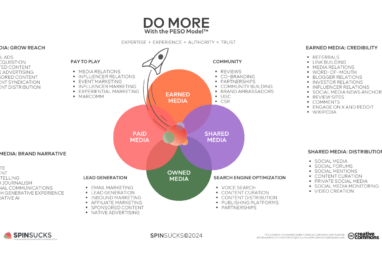The uncomfortable truth
Why taboo works in public relations

About the author
Laura Berman is a communications professional with experience within the design, architecture, and arts sectors. She wrote this piece as part of a CIPR Professional PR Diploma assignment.

Taboo – what is it
The Cambridge Dictionary defines taboo as ‘a subject, word, or action that is avoided for religious or social reasons’. Given this definition, it may seem surprising that public relations professionals often use taboo as a tool to engage with their audiences. What is it about the forbidden that is so enticing, and how does making people feel uncomfortable actually change their behaviour?
Context of taboo
There are many subjects that are universally deemed taboo, but it is also true that there are some beliefs, behaviours, and actions that are only considered as such in the context of a certain period, cultural group, or demographic.
Edward Bernays touted as the ‘Father of Public Relations’, understood the value of contextual taboo when he created the influential, and successful, ‘Torches of Freedom’ campaign for Lucky Strike. He took the taboo of women smoking, and turned it on its head, advertising the once shameful behaviour as something desirable. Almost 100 years later, the tables have turned. Health campaigns, such as anti-smoking campaigns have created shame and judgement around pregnant women, in an attempt to prevent people smoking.
Types of taboo
Within the long list of potential taboos, there are many that are off limit. But there are a few topics that are commonly used in-line with the current zeitgeist, such as sex, menstruation, swearing, mental health, cancer, disability, and racism. Depending on what the campaign is trying to achieve, an organization will tackle taboo differently. It is perhaps then useful to categorise the ways in which taboo is used in marketing into these four areas:
- Marketing a taboo product, e.g. BodyForm/Libresse’s ‘Blood Normal’ and ‘Viva La Vulva’ campaigns to sell menstruation products
- Using taboo to market a non-taboo product, e.g. United Colours of Benneton historic use of social issues such as racism and sexuality as a clothes retailer
- Crisis communications, e.g. KFC’s ‘FCK’ campaign in the unlikely crisis they had when they ran out of chicken
- Call to action around a taboo subject e.g. Public Health England’s ‘Protect Against STIs’ to encourage condom use

Some of the most famous examples of marketing with taboo lead with advertising as a major part of the campaign, especially when the objective is to sell products.
The difference between advertising and public relations is that advertising is attracting an audience, but public relations is building a community.
When taboo is used just for the sake of it, the content can veer into the realm of shock, driving audiences away in disgust. To build a community and influence behaviour change using taboo, something that makes people feel slightly, or very, uncomfortable, seems like a contradiction in terms.
So why does it work?
Emotional response
To connect with our audiences, Richard Petty and John Cacioppo developed the elaboration likelihood model (ELM) which separates communication into central and peripheral routes. The central route uses direct, rational arguments, for example ‘Getting a cervical screen can prevent you from developing cervical cancer’. The peripheral approach used cues and symbols to tap into the more emotional side of the viewer, for example using humour to break down the stigma women feel about their bodies in an effort to change their behaviour. Another way of looking at this is logos vs pathos, or logic vs emotion.
Taboo certainly elicits a strong emotional reaction and coupled with that it is out of the ordinary lexicon or behaviour of our day to day lives, so when it does appear it is all the more striking.
Studies suggest that references to taboo, or ‘taboo stimuli’, are more arousing and more memorable than other types of emotional references. On its own, something being memorable does not automatically mean that the audience will be influenced to change, however exploring the concept of arousal could provide more answers.
Arousal triggers a release of dopamine, a chemical that is a key element in the brain’s reward system. People experience a feeling of pleasure when dopamine is released, often associated with activities such as eating, sex, drug taking, or gambling. Dopamine also drives people to take action.
Tapping into the emotions of the audience can take a positive or negative approach, the former manifesting as virtue or humour, and the latter as fear or guilt, so being presented with a taboo might not always be an enjoyable experience. However, if using taboo in public relations can stimulate arousal and drive us to act, plus stay in the minds of the audience, it sounds like a recipe for success.
Negative and positive approaches
Being confronted with something that is uncomfortable creates tension – there is a disconnect between what the viewer believes to be right and good, and what they are being made to look at. Humour can often break tension and ease these situations. In the right context, it can also dispel the negative feelings associated with that taboo. When used in the wrong context, however, humour can seem to appear untactful or undermining of a sensitive issue, driving the audience away.
Fear and guilt can be successful tools, scaring audiences to action. But this can be a risky approach, especially when dealing with taboo. There is a fine balance to be created when engaging with someone using uncomfortable content such as taboo, so to double up on that with negative messaging may feel relentless to the viewer.
Public health campaigns employ both negative and positive techniques to encourage behaviour change, very often around taboo subjects such as sex, women’s health, smoking, and cancer. An interesting example is the recent initiative to encourage women to have a cervical screening test, and the different approaches taken by Public Health England and Public Health Wales. In response to NHS data that showed cervical screening in 2018 was at a 20-year low, a national campaign was launched in March 2019 to encourage women to attend appointments. As part of this initiative research was undertaken to ascertain why women weren’t attending. The results cited reasons such as embarrassment and body shame, concern about the procedure, lack of access to or knowledge of services, and lack of awareness of risk.
Public Health England’s campaign was titled ‘Cervical Screening Saves Lives’ and addressed issues by sharing practical information about the risks of not getting tested, such as getting cancer, and the realities of the procedure. While the style of the videos and images are soft focussed and earnest, hearing that death may be a result of your actions (or inaction) is certainly frightening.
Public Health Wales on the other hand used humour to address the challenge, with their campaign ‘#loveyourcervix’.
Today we launch the #loveyourcervix campaign. Women that attend for cervical screening when they are first invited aged 25 are more likely to attend in the future, significantly reducing their risk of developing cervical cancer. #loveyourcervix pic.twitter.com/autBb2gFju
— Public Health Wales (@PublicHealthW) March 12, 2019
The concept focussed on body positivity and breaking down the shame women felt, as the evidence showed that many women did not attend screenings as they were embarrassed about their body shape, the appearance of their vulva, their smell, and if they had not shaved or waxed their bikini area. In response Public Health Wales created humorous and relatable content, primarily using social media, including a GIF of the varied names women have for their vaginas, such as ‘foof’, ‘noo-noo’, ‘fanny’, and ‘twinkle’, encouraging people to join in with ‘What do you call yours?’ This catchy content was much more engaging and shareable, the latter being key when building a community with a campaign.
Can we all use taboo?
It could be argued that when marketing a product or service that is inherently linked to taboo, such as menstrual products or condoms, then embracing taboo in public relations is somewhat predetermined. It is just a case of how best to do it. But not all companies are promoting the risqué, so is taboo going to work for everyone as a public relations approach?
Understanding your audience
People respond to taboo differently based on their sociological perspectives. Even different people within the same context can respond differently to certain messages. Psychographic segmentation is a useful model to categorise the target audiences according to their attitudes, opinions, beliefs, and levels of self-esteem. Using a great campaign with the wrong audience is going to backfire.
Wieden+Kennedy New York’s ‘Commit To Something’ campaign for Equinox gyms explored the use of taboo for a non-taboo client. Many sports and gym companies use the trope of a passionate athlete succeeding at their goals to inspire the viewers and make them believe they can achieve the same. Wieden+Kennedy looked deeper at the target audience, finding that Equinox’s customers were mainly high net worth individuals, at the top of their game, who commit to everything they do with passion. With a creative and controversial twist, Wieden+Kennedy New York produced a series of images showing people committing to a whole range of things completely unrelated to sports, such as being in a cult, having multiple sexual partners, and breastfeeding not only in public but in a fine dining restaurant.

This campaign almost crosses the line of what is acceptable, but with a clear understanding of the target audience and a confident ‘tongue in cheek’ approach, it is a good example of how to embrace taboo where it might not usually be found.
It is well established that we now care about what a brand stands for, as much as we do the quality of its product or service, and this is another opportunity to use taboo. A trailblazer in this regard is United Colours of Benetton who have never been afraid to air their political position through the use of provocative campaigns, whose subject matter is seemingly unrelated to their product: clothing. However, it can be argued that United Colours of Benetton have sometimes veered into the realm of ‘shockvertising’ and their campaigns have often been met with negative feedback.
Doing it right
Whether promoting a taboo subject, or using taboo as a marketing tool, similar rules apply. It is important to understand the audience and how they will respond or react to the content. When building communities through public relations, it is important to understand that communication is not a one-way street, and that the public can be useful in sharing and disseminating the message. For this to happen, the content needs to be engaging and shareable, and humour can often be the differentiator in turning something that would normally be uncomfortable into something positive.
If taboo is simply not appropriate for you, then there are still lessons we can learn from what is possibly one of the more challenging marketing techniques. Looking at the psychology of how people react to certain stimuli, such as dopamine triggers, can help create campaigns and content that is effective in behaviour change.
Using taboo in public relations is not a new technique, but as times, contexts, and trends change, there are always audiences to reach. Although sometimes risky, taboo will always be worth exploring as a way to engage with the public.
References
-
- Cambridge Dictionary online (2008): Cambridge University Press https://dictionary.cambridge.org/
- Edward Bernays, ‘Father of Public Relations’ And Leader in Opinion Making, Dies at 103 (1995): The New York Times https://www.nytimes.com/1995/03/10/obituaries/edward-bernays-father-public-relations-leader-opinion-making-dies-103.html
- Creativity – Cannes Lions (2017) Blood (Bodyform – Libresse Ad). Available at: https://www.youtube.com/watch?v=N-yIBD7cOUg
- Librese Sverige (2017) Blood normal. Available at: https://www.youtube.com/watch?v=lm8vCCBaeQw
- Libresse “Viva la vulva” by AMV BBDO (2018): Campaign https://www.campaignlive.co.uk/article/libresse-viva-la-vulva-amv-bbdo/1519742
- Waters (2016). Six tips for brands to follow when tackling taboos in advertising: Campaign https://www.campaignlive.co.uk/article/six-tips-brands-follow-when-tackling-taboos-advertising/1411332
- Brownsell (2018). KFC: A very fcking clever campaign: Campaign https://www.campaignlive.co.uk/article/kfc-fcking-clever-campaign/1498912
- Public Health England (2017). Campaign to protect young people from STIs by using condoms: Gov.uk https://www.gov.uk/government/news/campaign-to-protect-young-people-from-stis-by-using-condoms
- McGovern, T. (2014). Using humour in healthcare marketing: PMLiVE http://www.pmlive.com/blogs/smart_thinking/archive/2014/november/is_laughter_the_best_medicine_609402
- Elmoisheer, S. (2017). The combination of taboo advertising with humor: SAIL https://sailemagazine.com/2017/01/the-combination-of-taboo-advertising-with-humor/
- Dopamine (n.d): Psychology Today https://www.psychologytoday.com/gb/basics/dopamine
- Brookshire, B (2013). Dopamine Is…? : Slate.com https://slate.com/technology/2013/07/what-is-dopamine-love-lust-sex-addiction-gambling-motivation-reward.html
- One in three women don’t attend cervical screening because of ’embarrassment’ (2018): NHS.uk https://www.nhs.uk/news/cancer/one-three-women-dont-attend-cervical-screening-because-embarrassment/
- Public Health Wales (2019). #loveyourcervix campaign launches today: wales.nhs.uk http://www.wales.nhs.uk/sitesplus/888/news/50607
- Public Health England (2019). PHE launches ‘Cervical Screening Saves Lives’ campaign: Gov.uk https://www.gov.uk/government/news/phe-launches-cervical-screening-saves-lives-campaign
- Third of under-30s in Wales snub cervical smear tests (2019): BBC.co.uk https://www.bbc.co.uk/news/uk-wales-47528672
- Pritchard, O. (2016) Wieden+Kennedy’s provocative Commit to Something campaign for Equinox: It’s Nice That https://www.itsnicethat.com/articles/wieden-kennedy-steven-klein-equinox-130116
- Madan, R., Shafer, A T., Chan, M., Singhal, A. (2016) Shock and awe: Distinct effects of taboo words on lexical decision and free recall: The Quarterly Journal of Experimental Psychology https://www.researchgate.net/publication/295550230_Shock_and_awe_Distinct_effects_of_taboo_words_on_lexical_decision_and_free_recall
- Pilkington, A., Ruck, K., Tucker, C., Yaxley, H. (2017) CIPR Professional Diploma Reader 2017-18: PR Academy
- Theaker, A., Yaxley, H. (2017) The Public Relations Strategic Toolkit : An Essential Guide to Successful Public Relations Practice: Routledge
- Perloff, R M. (2017) The Dynamics of Persuasion: Communication and Attitudes in the Twenty-First Century: Routledge


